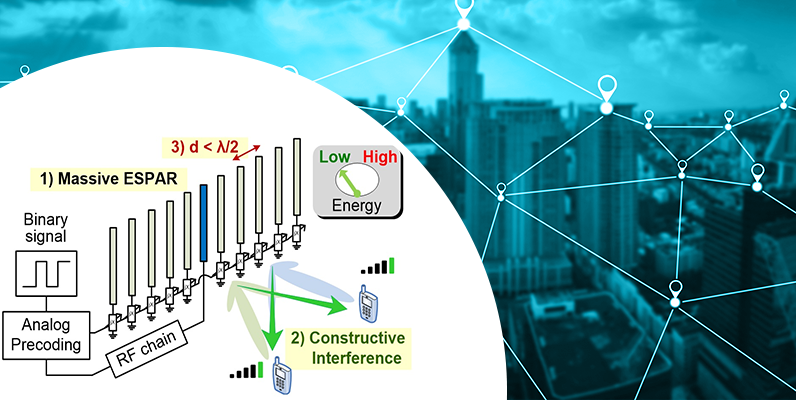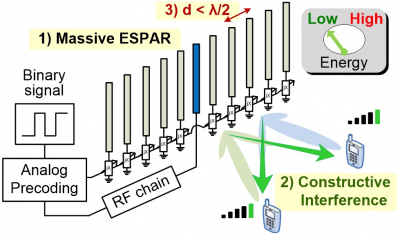Large Scale Antenna Systems Made Practical: Advanced Signal Processing for Compact Deployments
This page has been archived and will no longer be updated

6 July 2018
Developing massive MIMO solutions for practical 5G deployments
Funder EPSRC
Amount 550 000 GBP (total)
Project website http://gtr.ukri.org
Description
This project investigates signal processing techniques for practical and realistic implementations of large-scale antenna systems (LSAS) for energy- and spectral- efficient wireless communication.
It is expected that the energy bill for cellular networks will double by 2015 and therefore there is a growing concern to reduce the associated operational expenditure (OPEX) along with the global CO2 emission in all fields of communications.

The physical limitations of wireless propagation form the bottleneck of physical layer transmission. Multiple Input Multiple Output (MIMO) systems have proven particularly useful in circumventing this bottleneck by providing an increased number of data streams in the physical channel. Small-scale MIMO systems are currently part of communication standards and commercial designs.
LSAS are envisaged for the next generations of wireless systems, to capitalise on the utilisation of multiple antennas, and deliver the transmission rates required for future communications in a power-efficient manner. LSAS involve several critical benefits:
- The transmit power is split to many low power antennas, of the order of milliWatts.
- Hence, the design of the radio frequency (RF) front-end components is simplified as low-cost power amplifiers can be deployed.
- LSAS designs can be extremely robust in that the failure of one or a few of the antenna units would not appreciably affect the system.
- In terms of signal processing, by scaling up the dimensions of MIMO low complexity user detection and precoding become close-to-optimal.
- In information theoretic terms, as the numbers of antennas grow infinitely large, the statistics of the MIMO channel tend to deterministic functions.
and associated challenges:
- The massive amount of RF chains required to feed the hundreds of antennas poses an important practical challenge in their deployment,
- With the increase of spatial dimensions, the complexity of even the simplest signal processing techniques increases significantly
- The massive antenna arrays must be deployed in the limited physical space that is available in both base stations and mobile devices. This creates two main effects which become particularly relevant in LSAS: spatial correlation due to the proximity of the antennas as signal sources and mutual coupling due to the proximity of the antennas as electrical components.
For large numbers of antennas, pilot sequences for channel estimation have to be reused between adjacent cells. Channel State Information (CSI) provisioning becomes a significant burden and the performance of LSAS becomes limited by the resulting inter-cell interference (pilot contamination problem).
This project tackles the issue of large-scale antenna deployment by a) information theoretical analysis with realistic modelling, b) signal processing and CSI acquisition devoted to power efficiency and c) analogue-digital beamforming designs and reduced RF-chain solutions aimed at power- and cost-effective implementations.
The project aims to achieve power-efficient transmission by large-scale antenna systems based on two key disruptive concepts: a) using analogue beamforming using the principles of Electrically-Steerable Parasitic Array Radiators (ESPAR) based LSAS and b) exploiting constructive interference.
In addition, this project re-examines the anticipated benefits of LSAS from the viewpoint of realistic deployments of the antenna arrays in limited physical space which are prone to increased correlation and coupling between the densely deployed antennas.
We aim at a thorough and pragmatic investigation of the benefits of LSAS for Green Communications, and their practical implementation solutions.
Outputs
- Publications
S. Payami, N. Balasubramanya, C. Masouros, M. Sellathurai, “Phase Shifters vs Switches: An Energy Efficiency Perspective on Hybrid Beamforming”, IEEE Wireless Comms Letters., in press
J. Qian, A. Garcia and C. Masouros, “Incomplete CSI Acquisition for Size-Constrained Massive MIMO Systems with User Mobility”, IEEE Trans Veh Tech., in press
X. Xue, Y. Wang, L. Dai, C. Masouros, “Relay Hybrid Precoding Design in Millimeter-Wave Massive MIMO Systems”, IEEE Trans. Sig. Proc., vol. 66, no. 8, pp. 2011-2026, April 2018, DOI: 10.1109/TSP.2018.2799201
A. Li, C. Masouros, and M. Sellathurai, “Analog-Digital Beamforming in the MU-MISO Downlink by use of Tunable Antenna Loads”, IEEE Trans. Veh. Tech., vol. 67, no. 4, pp. 3114-3129, April 2018 DOI: 10.1109/TVT.2017.2776563
C. Neil, A. Garcia, P. Smith, P. Dmochowski, C. Masouros, M. Shafi, “On the Performance of Spatially Correlated Large Antenna Arrays for Millimeter-Wave Frequencies”, IEEE Journal on Antennas and Propagation., vol. 66, no. 1, pp. 132-148, Jan. 2018 DOI: 10.1109/TAP.2017.2759842
F. Liu, C. Masouros, P. Amadori, H. Sun “An Efficient Manifold Algorithm for Constructive Interference based Constant Envelope Precoding”, IEEE Sig. Proc. Let., vol. 24, no. 10, pp. 1542-1546, Oct. 2017 DOI: 10.1109/LSP.2017.2748230
P. V. Amadori and C. Masouros, “Large Scale Antenna Selection and Precoding for Interference Exploitation”, IEEE Trans Comms., vol. 65, no. 10, pp. 4529-4542, Oct. 2017 DOI: 10.1109/TCOMM.2017.2720733
A. Garcia, C. Masouros, and P. Rulikowski “Reduced Switching Connectivity for Power-Efficient Large Scale Antenna Selection”, IEEE Trans. Comms., vol. 65, no. 5, pp. 2250-2263, May 2017, DOI: 10.1109/TCOMM.2017.2669030
A. Li and C. Masouros, “Exploiting Constructive Mutual Coupling in P2P MIMO by Analog-Digital Phase Alignment”, IEEE Trans. Wireless Comms., vol. 16, no. 3, pp. 1948-1962, March 2017, DOI: 10.1109/TWC.2017.2657631
A. Li, and C. Masouros, “Hybrid Analog-Digital mmWave MU-MIMO Transmission with Virtual Path Selection”, IEEE. Commun. Lett., vol. 21, no. 2, pp. 438-441, Feb. 2017, DOI: 10.1109/LCOMM.2016.2621741-
 Close
Close

